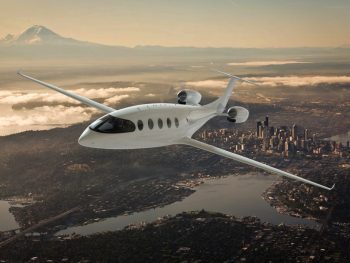Fantasy Fleet: Eviation Alice electric jet
Fed up with the usual limousine suspects but don’t want to worry about your carbon footprint? Then the Eviation Alice electric jet could be just the you need…

The Eviation Alice electric jet
Price: £3.24m Hourly direct operating cost: £162.24 Length: 17.40m Width: 3.84m Height: 19.20m
Max cruising speed: 298mph Passenger spaces: Six Flying range: 440 nautical miles
Noise: 100 times quieter on take-off than a jet-fuelled model Likelihood of making it onto the fleet? 1/10
Ground vehicles aren’t the only ones going through the switch to electrification – Eviation is just one of a growing number of aircraft manufacturers that are busy developing battery-powered beauties for the air. And these aren’t the run-of-the-mill ‘flying cars’ you might have seen. These are the real thing – proper private jets that are truly fit for purpose.
The Eviation story began in 2015 when it was founded by Omer Bar-Yohay and Aviv Tzidon, both of whom served in the Israeli military. The first product to come out of the business was the Orca in 2017 – a 1:4 scale drone that was inspired by the mammal of the same name. Fast-forward to 2020 and the company shifted its headquarters to Arlington WA in the US, ahead of planned manufacturing requirements.
One year later, the all-electric Alice was unveiled and, at the time, the company was looking at a market introduction of 2024. Subsequent announcements have seen aircraft delivery dates pushed back to 2027 as production is ramped up. The Alice is a six-passenger, two-crew member aircraft that offers the triple benefits of zero carbon emissions, quiet (relatively speaking) operation and lower running costs than a traditional jet. Last year, the Alice successfully took to the skies in a test flight and the company believes it is on the right path to offering a true zero-emission offering in the aviation world.
Powering the Alice are two Magni650 propulsion units – each offering 939hp – from MagniX, while fly-by-wire technology from Honeywell is also onboard. The aircraft’s battery system is made from currently available components, so is not dependent on future technological developments. The added benefit of that scenario is that pilots will not be required to undertake any form of new training on any innovative kit in order to fly Alice. Which is great for them because they will no doubt be champing at the bit to be in control of crafts that are potentially on the cusp of an aerospace revolution.
By November 2022, the company had received orders for more than 300 aircraft. While that might seem like a relatively small number, there are some reputable clients on the list who have pledged their (financial) support to the new electric machines. DHL Express kicked off the order bank back in the middle of 2021 and its deposit was soon joined by similar ones from the likes of Cape Air, GlobalX and EVIA AERO. Meanwhile, a partnership with Clay Lacy Aviation has been signed for charging facilities at its Fixed Base Operator (FBO) sites around the world.
What’s the Alice like? Luxurious, as you might expect. Just because the power source has changed, the demands of customers haven’t. There’s a fully equipped galley with toilet and sink and, according to Eviation, Alice boasts the widest cabin in its class. Panoramic windows measuring 22 inches high and 16.5 inches wide provide great views from the air, while passengers need not worry about baggage allowances as the Alice offers 100 cubic feet of space!
As far as mobility solutions go, a private jet might not be the most conventional, but “never say never”. You never know when you might need room for you and five colleagues to arrive somewhere in style and a seven-seater passenger car – or even a limo – just won’t cut the mustard.












